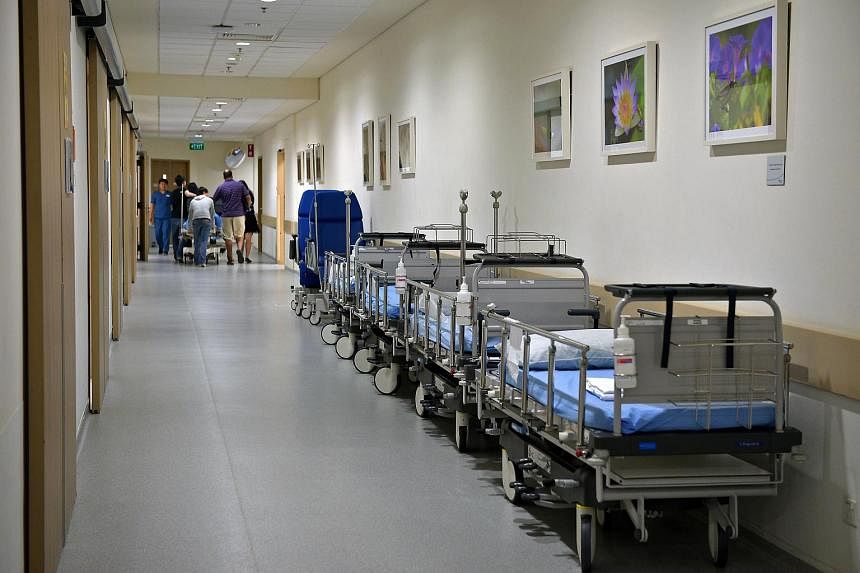The year 2015 should turn out to be a good year, as far as health care is concerned - barring unexpected developments. In fact, if all goes well, it should be the start of a few good years, as the hard work of the past comes to fruition.
Bed crunch eases
First, the severe bed crunch facing public hospitals should ease this year. The shortage still exists - some hospitals still report 100 per cent occupancy on some days and patients are still being put up in makeshift waiting areas, including corridors.
But this should ease as the year progresses.
The bed crunch was exacerbated last year by the six-month delay in the opening of the 700-bed Ng Teng Fong General Hospital in Jurong. It is now scheduled to open by the middle of this year.
Changi General Hospital made good its promise to open the new 280-bed integrated building it shares with St Andrew's Community Hospital by 2014 - but with just 20 beds at the end of last month. By end-January, another 10 beds will be ready. By July, 200 more beds will be up.
With the extra beds from the two hospitals, the load on both the National University Hospital and the Khoo Teck Puat Hospital will be lighter.
In all, there should be a 10 per cent increase in public general hospital beds this year - from more than 7,200 beds to about 8,000 beds - giving all hospitals some breathing space.
Lower costs
Next, the rising cost of health care, especially for older people, will be reined in.
The entire Pioneer Generation Package of health subsidies for the elderly (those aged 65 and above last year) kicks in this year, from higher medication subsidies from Jan 1 to hefty subsidies for medical insurance by the end of this year.
Pioneers get a minimum $28.50 in subsidy when seeing a general practitioner in a private clinic, and at least $21 when seeing a dentist. From this year, the medication costs will be halved at hospitals and polyclinics for subsidised patients.
The rest of the working population will enjoy higher contributions from employers to their Medisave accounts. Employers will pay an extra 1 percentage point into members' Central Provident Fund Medisave accounts.
Home care
More has also been done to help families keep their frail or sick elderly at home, with more respite-care and home-care services coming online.
More eldercare centres will open on weekends, to give caregivers and families time to do things of their own.
Patients with chronic ailments will also enjoy more "preventive" care in the community, so they will not need frequent hospital stays.
All public hospitals now have programmes to identify patients who are likely to need frequent hospital stays. These patients get visits to their home from doctors, nurses, allied health-care professionals and social and other aid workers to ensure they remain as healthy as possible - and out of hospital.
MediShield Life
And to wrap up the year, MediShield Life is set to kick in before the year ends.
This universal health insurance coverage was first promised by Prime Minister Lee Hsien Loong in his National Day Rally speech in August 2013.
By November that year, a high-level committee was set up to find out what people wanted and what was doable under such an insurance plan.
Over a six-month period, committee members spoke with more than 1,200 Singaporeans, and submitted their proposal in June last year. This was accepted by the Government, which has promised to see it implemented by the end of this year.
This scheme will provide every resident with basic medical insurance for life, regardless of his or her health status.
Premiums are being kept affordable with huge government underwriting - an estimated $4 billion for the first five years.
Everyone will get some help to pay the premiums in the initial years, with the old and the less well-off getting subsidies on a prolonged or permanent basis.
The Bill allowing this is expected to be passed in Parliament early this year, likely in the first quarter.
With MediShield Life, high government subsidies in public hospitals of up to 80 per cent, and more money in their Medisave accounts to offset the cash payments, most patients who opt for subsidised wards should have little difficulty affording the cost of their care.
For those who still have problems meeting their hospital bills, the health safety net in the form of the government-sponsored Medifund will step in.
So 2015 will see enough hospital beds for all who need them, and patients will find paying for their hospital care less of a financial burden. And even better still, more old people will find it easier to get proper care without needing a hospital stay.


